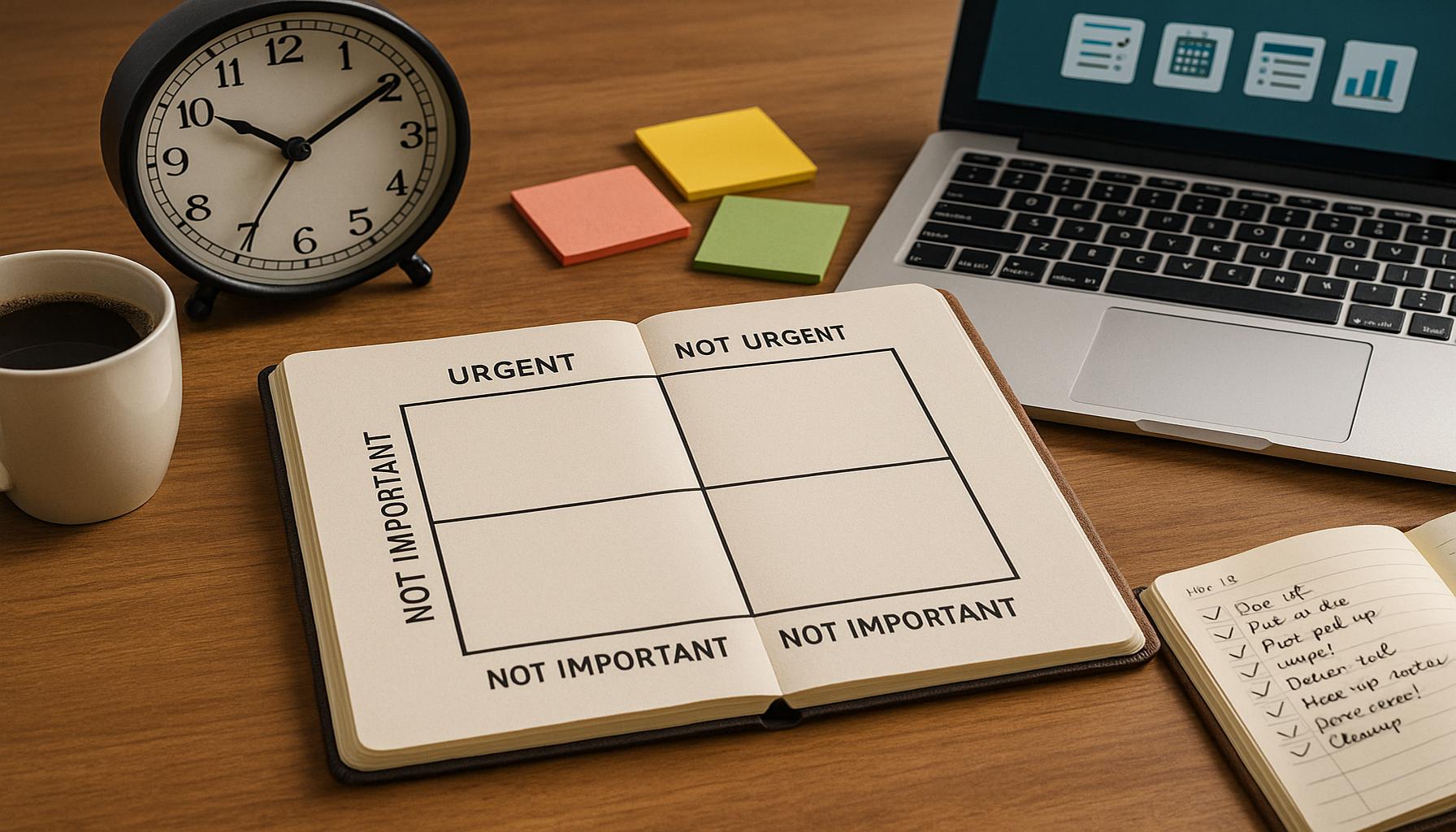How to Use the Eisenhower Matrix for Better Time Management

Understanding the Eisenhower Matrix
In a world overwhelmed by commitments and distractions, mastering time management can feel like a daunting task. However, the Eisenhower Matrix emerges as a robust strategy for individuals seeking to prioritize tasks effectively and streamline their daily activities. Named after the 34th President of the United States, Dwight D. Eisenhower, who famously stated, “What is important is seldom urgent, and what is urgent is seldom important,” this tool provides clarity in a chaotic environment.
The matrix categorizes tasks into four distinct quadrants based on two criteria: urgency and importance. By doing so, it encourages individuals to assess where they spend their time and energy:
- Urgent and Important – These tasks demand immediate attention and directly contribute to your goals. For instance, meeting a project deadline or addressing a sudden health issue falls into this category. Treating these tasks with priority ensures you are responding effectively to critical situations.
- Important but Not Urgent – These activities are essential for long-term success but don’t require immediate action. For example, developing skills through courses or building relationships through networking can significantly elevate your career prospects if planned effectively.
- Urgent but Not Important – Often, these tasks can lead to false urgency. For example, handling minor email requests or attending meetings that do not contribute to your objectives may seem pressing but can often be delegated or rescheduled. Recognizing these tasks frees up valuable time.
- Neither Urgent nor Important – This quadrant includes distractions such as excessive social media scrolling or engaging in activities that do not serve your personal or professional growth. Identifying and eliminating these tasks can drastically improve productivity.
Employing the Eisenhower Matrix transforms how you visualize and evaluate your workload. By consciously categorizing your tasks, you can allocate your time and energy more effectively. For example, a project manager might use the matrix to prioritize tasks for the week ahead, ensuring that significant deadlines and strategic planning are highlighted while delegating less crucial tasks to team members.
This approach is not just beneficial for professionals but can also be advantageous for students juggling coursework, extracurricular activities, and personal obligations. By implementing this method, students can identify when to study for an upcoming exam (Urgent and Important) or plan out a research project (Important but Not Urgent), allowing for a balanced and structured schedule.
In summary, the Eisenhower Matrix offers a structured path to reclaim control over your time, making it a vital tool for anyone wishing to elevate their productivity levels. With practice, this framework can guide you to make conscious choices about your commitments, ultimately enhancing your ability to achieve personal and professional aspirations.

Implementing the Eisenhower Matrix in Your Daily Routine
To effectively use the Eisenhower Matrix, it’s essential to integrate it into your daily routine with intention and method. The matrix is not merely a theoretical concept; it demands practical application to fully transform your time management skills. Here’s how to effectively harness this powerful tool in your everyday life:
Step 1: Create Your Matrix
The first step in utilizing the Eisenhower Matrix is to create a physical or digital version of the matrix. You can draw a simple four-quadrant box on a notepad, whiteboard, or use project management software or apps that allow you to categorize tasks. Label the quadrants:
- Quadrant I: Urgent and Important
- Quadrant II: Important but Not Urgent
- Quadrant III: Urgent but Not Important
- Quadrant IV: Neither Urgent nor Important
Step 2: Categorize Your Tasks
Once your matrix is set up, take a moment to list all the tasks you need to accomplish. Be comprehensive in your approach; include both personal and professional responsibilities. Then, categorize each task into one of the four quadrants. This process may seem straightforward but requires honesty and a clear understanding of your priorities. Consider these questions:
- Does this task directly impact my immediate goals?
- Is there a looming deadline or urgency attached to this task?
- Can this task be delegated or postponed without harming outcomes?
- Is this task simply a distraction from more pressing matters?
Step 3: Prioritize Effectively
With tasks categorized, it’s time to prioritize. Tasks in Quadrant I should be your main focus. Addressing these tasks ensures that you are managing your time effectively and responding to what matters most. Quadrant II, while not urgent, is critical for long-term success. Allocate specific time slots in your week to work on these important tasks, as neglecting them can lead to future urgency. Quadrant III tasks should be evaluated for delegation or even elimination. Finally, find ways to minimize or eliminate Quadrant IV tasks altogether, as they do not contribute to your productivity.
Step 4: Review and Adjust
Time management is an evolving practice. Review your matrix at the end of each week or once a month to evaluate its effectiveness. Are pressing issues arising from supposed “important” tasks? Adjust your categorization and handling methodology accordingly. This reflection helps you refine your approach and adapt to ever-changing responsibilities.
By implementing these steps, you can harness the full potential of the Eisenhower Matrix, leading to better time management skills and ultimately a more satisfying and productive life. Understanding how to prioritize not only uplifts your professional performance but also enhances personal fulfillment, allowing you to engage more deeply in activities that matter to you.
| Category | Description |
|---|---|
| Increased Focus | The Eisenhower Matrix helps prioritize tasks, ensuring that attention is directed towards what matters most. |
| Enhanced Decision-Making | This method encourages critical thinking about task importance, leading to more effective choices in time management. |
| Reduced Stress | By distinguishing urgent from non-urgent tasks, users can alleviate overwhelm and create a balanced schedule. |
| Improved Productivity | Implementing the matrix leads to optimized workflows, resulting in accomplished more within the same time frame. |
Implementing the Eisenhower Matrix effectively involves categorizing your tasks into four quadrants based on urgency and importance. Focus on the first quadrant for tasks that require immediate attention while maintaining awareness of less critical tasks in the other quadrants. By engaging in this systematic approach, individuals often find themselves navigating through their to-do lists more efficiently, prioritizing responsibly, and experiencing a noticeable boost in both morale and time management skills. This method not only cultivates a mindset conducive to productivity but also fosters space for reflection and strategic planning, making it an invaluable tool in the realm of effective time management.
Adapting the Eisenhower Matrix to Different Scenarios
Utilizing the Eisenhower Matrix is not a one-size-fits-all solution. Since we all lead different lives filled with unique responsibilities, it’s essential to adapt the matrix for various scenarios, personalizing it to fit individual circumstances and responsibilities effectively. Here’s how different environments and situations can influence the way you apply the matrix:
Workplace Applications
In a professional setting, the Eisenhower Matrix can be particularly beneficial for managing multiple projects or deadlines. For instance, if you are a project manager juggling various tasks, use the matrix to assess team members’ assignments based on their urgency and importance. As you classify tasks into the quadrants, consider your team’s strengths and weaknesses. If certain team members excel in critical thinking, you might want them on important but not urgent tasks in Quadrant II, fostering strategic planning and innovation.
Moreover, in the fast-paced corporate environment, communicating the matrix framework can cultivate a culture of prioritization among employees. Regular team meetings to reassess tasks using the matrix encourages collaborative problem-solving, ensuring that everyone remains aligned and focused on priority outcomes.
Personal Life Integration
Time management is equally vital in personal settings. Utilizing the Eisenhower Matrix can help streamline your daily life, from family responsibilities to personal hobbies. For example, when planning your weekends, consider how tasks such as grocery shopping and family gatherings fit into the quadrants. Family events might fall under Quadrant II—important but not urgent—highlighting the need to schedule quality time proactively to strengthen relationships.
Additionally, reflecting on personal goals, which often reside in Quadrant II, can help bring clarity and motivation. Start integrating activities that contribute to personal growth, such as enrolling in a course or volunteering. These commitments often do not seem urgent, and without proper planning, they can quickly fall to the wayside.
Utilizing Technology
In today’s digitized world, technology can significantly enhance your ability to implement the Eisenhower Matrix. Numerous applications designed for time management offer features that allow you to categorize tasks and set reminders specifically tailored to each quadrant. For example, tools like Todoist or Trello can enable you to visually manage tasks according to priority while integrating deadlines and reminders, which is particularly useful for keeping urgent tasks from overwhelming you.
Furthermore, setting up notifications serendipitously nudges you to focus on tasks in Quadrant II, ensuring you dedicate time to activities that propel you towards long-term success. Consider employing these digital tools to streamline the categorization process and cultivate an organized work environment, ensuring you never lose sight of what truly matters.
Common Challenges and Solutions
Despite its effectiveness, integrating the Eisenhower Matrix can present challenges. One common issue is misjudging the urgency or importance of tasks. To combat this, regularly revisit your tasks to enhance clarity. Another challenge is becoming overwhelmed by urgent but not important tasks that demand immediate attention. To address this, practice delegating those tasks whenever possible, allowing you to concentrate on what advances your goals.
In sum, adapting the Eisenhower Matrix to various scenarios and leveraging technology can significantly enhance its efficacy for anyone aiming for better time management. The nuances in its application reflect the diverse nature of our lives, paving the way for a more organized approach to achieving both immediate and long-term objectives.
Conclusion: Mastering Time Management with the Eisenhower Matrix
In our fast-paced lives, effective time management is crucial for success and well-being. The Eisenhower Matrix stands out as a valuable tool for prioritizing tasks and deciphering what truly requires our attention. By distinguishing between urgent and important activities, we can cultivate a framework that not only enhances productivity in our professional careers but also enriches our personal lives.
As explored throughout this article, the adaptability of the Eisenhower Matrix makes it applicable in various scenarios, whether it be managing deadlines in the workplace or planning quality time with loved ones. The integration of technology adds an extra layer of efficiency, enabling us to track our priorities and commitments with ease. However, awareness of common challenges—such as misjudging task significance or becoming bogged down by urgency—serves as a reminder to periodically reassess our tasks and maintain focus on what drives growth.
In conclusion, the effectiveness of the Eisenhower Matrix is significantly enhanced when personalized and integrated into daily routines. By taking actionable steps to understand your own priorities and leveraging digital tools, you equip yourself with the ability to make informed decisions that optimize your time management strategy. Consider continuing to explore this framework, refining your approach to not only meet immediate deadlines but also to achieve long-term objectives and personal fulfillment. Embrace the principles of the Eisenhower Matrix, and watch as it transforms your productivity and life balance.
Related posts:
The Impact of Time Management on Team Productivity
Overcoming Procrastination: Strategies for Managers
Strategies for Delegating Tasks to Enhance Team Productivity
The Importance of Prioritization in Time Management
Techniques for Effective Delegation in Management
Balancing Work and Personal Life Through Time Management

Linda Carter is a writer and time management specialist who helps professionals optimize their schedules and maximize productivity. With extensive experience in efficiency techniques and work-life balance strategies, she shares practical time management methods on our platform. Her goal is to empower readers with actionable systems to take control of their time, reduce stress, and achieve both professional and personal goals.